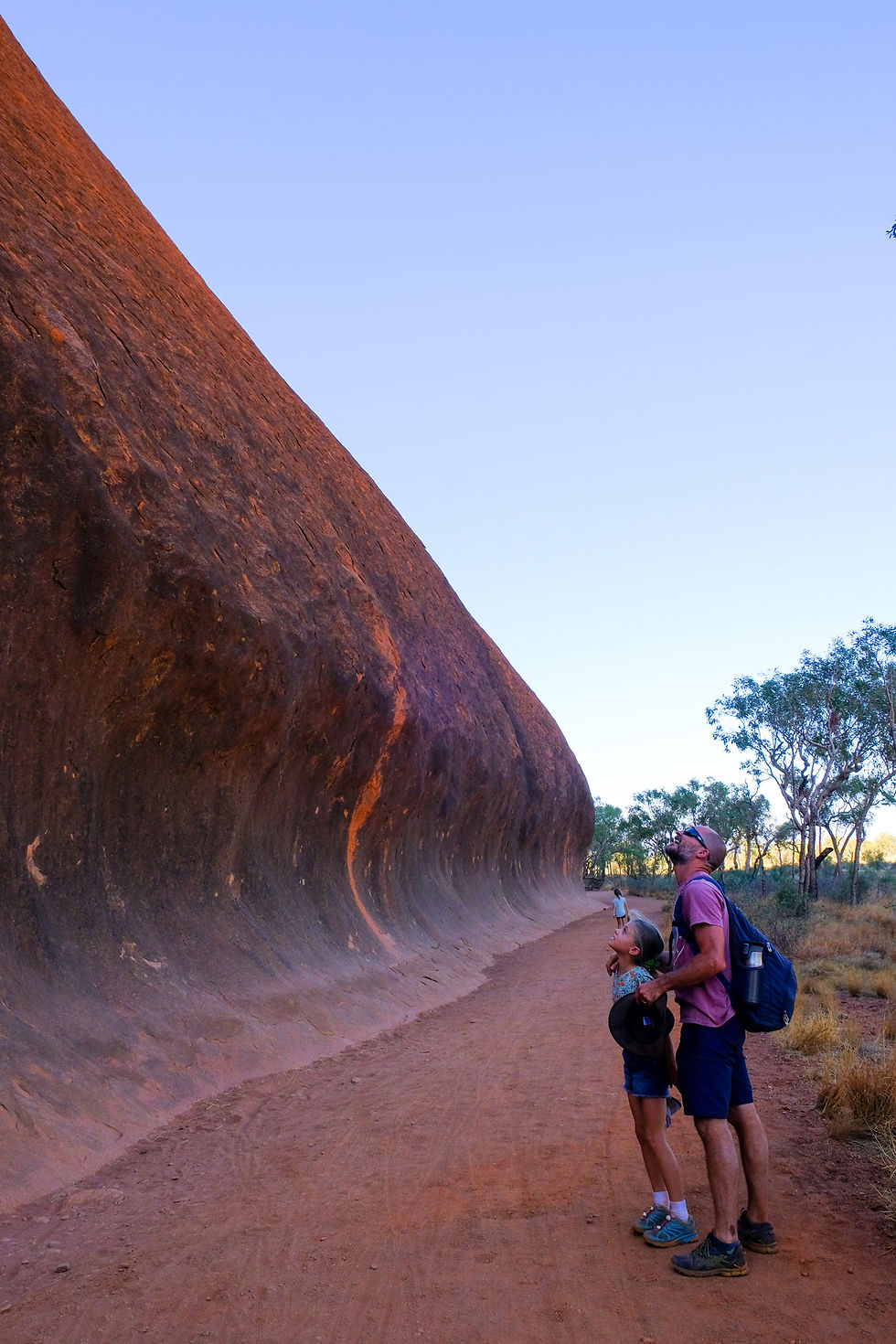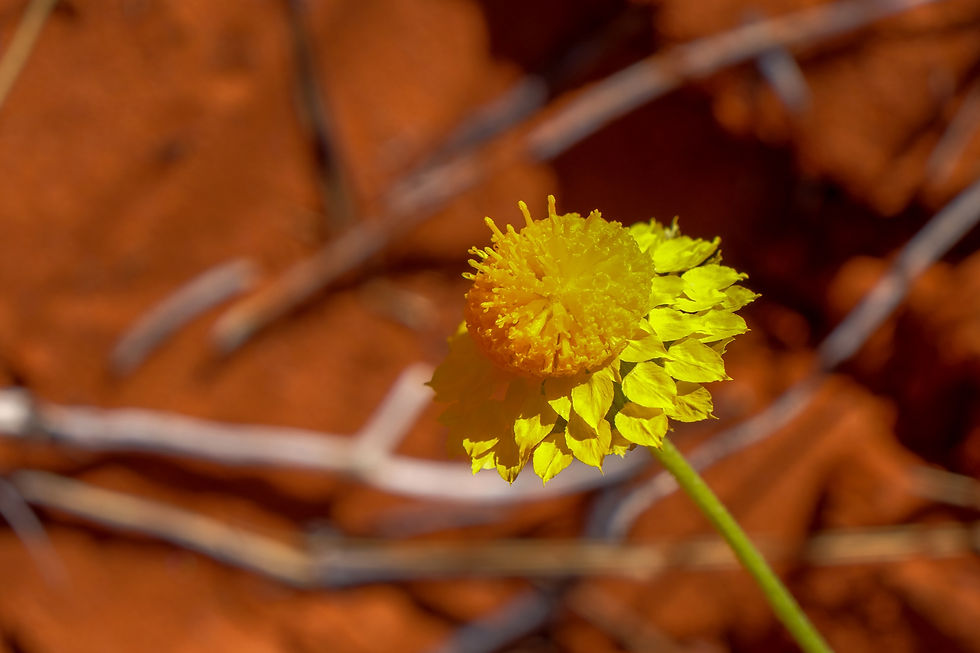Uluru & Kata Tjuta
- Beck
- Sep 13, 2019
- 4 min read
Upon arriving at our campground in Alice Springs, we were met with a very apologetic man telling us unfortunately there were no camp spots left on grass. I had to laugh, as we haven’t camped on grass in months (well, not living grass, anyway). He told us in a rather defeated manner, that he could show us what he had left anyway. He delivered us to a campsite that was gravel. We could barely contain our excitement! Gravel after camping on fine dust is heaven. I may even be able stay dust free for a day. Our first day in “Alice”, as the locals affectionately call it, was spent washing, fixing the car, etc. However, we did make it into town to catch the monthly night market which also coincided with the opening of Desert Festival, and we were lucky enough to catch some entertainers perform.
Over the course of the previous few weeks we had been asked many times if we had booked our campsite at Yulura as it has been so busy. Yulara is a purpose-built town that exists exclusively for accommodating tourists visiting Uluru-Kata Tjuta National Park. When a man at the information centre in Alice confirmed that indeed it was extremely busy, we decided for the first time, to book ahead. Booking ahead meant we jumped online and booked for the next night. They are so busy, they were not even answering phone calls to take bookings. This is due to the influx of tourists wanting to climb Uluru before the climb closes on the 26th October this year. Many tourist have showed up expecting to be accommodated and then finding out nothing is available. Funnily enough, we found there to be plenty of unpowered camping available - I assume because most people don't want to camp in the cold! Lucky we are tough Queenslanders who love the cold...
Uluru is 500kms from Alice Springs. When we were getting closer, we were wondered how Uluru would look when we first caught sight of it. I must admit, as it is such an Iconic image of Australia and very popular with tourists, I wondered if it would live up to expectation. I can say without a doubt that it is an amazing sight to behold. It is completely unique to anything I have ever seen, and it is amazing how the different light throughout the day can give it a completely different appearance. After arriving and setting up our tent, we quickly set out to view Uluru as the sun set. At last light, the enormous rock is lit up brightly, before the sun quickly disappears, giving it a softer more subdued look, although still striking.
After a very cold night where the temperature inside our tent went down to 3C, we defrosted ourselves enough to make it in time to a ranger led walk at the base of Uluru called The Mala Walk. It was great to get an insight into the significance Uluru has to the local Aboriginals, the Anangu. Uluru is sacred to the Anangu and ceremonial rituals are still carried out here. After the Mala walk, we did the base walk which leads you around the entire base of Uluru – approximately 11kms or more. Even though it was long, the girls say it was one of the easiest walks we have done this trip as it was entirely flat. You can even hire bikes or do Segway tours around the base. It was fascinating seeing Uluru up close from many angles. The amazing rock formations and vegetation growing around the base are beautiful. I had always imagined it being more of a sheer rock that led to a barren ground. There is plenty of life around the base of Uluru and I imagine it would be breathtaking during rain, when water falls over gullies forming instant waterfalls. We chose to respect the wishes of the Anangu Aboriginals, and did not do the climb to the top of Uluru.
We rose early the next day so we could drive out to Kata Tjuta, also known as “The Olgas” and complete the Valley of The Winds Walk before it got too hot. It was stunning. They have a similar appearance to Uluru, however, on closer inspection, you can see that most of the rock is made up of conglomerate and instead of walking around the base you are walking through the formations and over rocks and valleys. Parts of the walk reminded me of The Bungle Bungles. Our visit to Kata Tjuta was finished with the short walk into Walpa Gorge. Another spectacular gorge and some respite from the heat. I find it amazing that it can be so cold at night, yet extremely hot during the day! By our third night, however, it was heating up and once again my -14C (comfort level is meant to be -7C) sleeping bag was too hot. I was so focused on the cold part of this trip being tolerable, that I didn’t really consider the other 99% of the trip. I’ve only slept with my sleeping bag zipped up twice. Not that I’m complaining!!
After leaving Uluru-Kata Tjuta National Park, we stopped at the Mt Connor lookout. This mountain is often confused with Uluru upon first sighting it (and yes, we were also tricked at first). It is about the same size of Uluru and we find it amazing that this is not also another popular tourist destination. Apparently, as it is on private land, the Aboriginals have sadly lost their connection with the mountain. Across the road from the viewing point of Mt Connor is an amazing dry Salt Lake. The walk down to the lake revealed many beautiful little wildflowers. I am fascinated by these desert tolerant plants. They are easy to miss if you are not looking for them. I tried to photograph as many as I could without testing the patience of my fellow travellers too much. This was unsuccessful as I actually got Sarah and I lost as we completely missed the path and Myah and Mark had to come back looking for us. Too focused on taking flowers! I later found out that if there had been any rain lately, the whole area would be covered in wildflowers. Lucky for everyone's sake there were just a few for me to capture!
Our next destination is Kings Canyon, Watarrka National Park.





























Kata Tjuta




































Wow Becky, absolutely sensational photos of Uluru, Mt Cotton, and the other one I can't be bothered to scroll back up and remind myself the name of. I enjoyed seeing the struggles of the Uluru climbers in both directions, with the "Please don't climb" request also in shot - great work Becky. So does climbing permission cease for good on October 26th?
Thanks again for another magical insight into your amazing trip!
Another wonderful story of your travels and I love the up close photos of the plants, flora & fauna coming together.